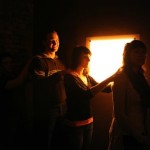The loud sounds of the kitchen… the yelling of the hostess as someone’s children run around the restaurant-turned-playground…the rude patrons or worse yet – rude servers. These are all things many of us expect when we dine out. Have you ever looked at your plate and thought “THAT does not look edible!”?
Most of us rarely take the time to interact with our servers or our food. Instead we rush to sit, rush to order, rush to eat and rush to leave. Rarely do we take the time to absorb ourselves in the textures, the flavours, the service, and truly experience the meal.
A seemingly new trend of restaurant theming is poised to change all of that while also educating diners.
Theming a restaurant based on what society considers a “handicap” sounds like a strange idea, but it does make a lot of sense. Theming a restaurant with a spin to bring patrons into the silent world of the deaf is a novel concept for many to consider. Not only are all the servers and hosts/hostesses deaf, but diners are not allowed to order using their voices. Instead, all patrons must use ASL (American Sign Language) to order their meals (based on directions from the menu)! This makes for a very interesting, educational and surprisingly fun experience. Signs, a restaurant in Toronto Canada, is staffed by mostly deaf employees (35 on average currently). This amazing theme has the added benefit of allowing a community to enjoy working in an industry that traditionally has disregarded what they can offer.
Working in an industry and location that not only allows you to be yourself, but to celebrate your differences is an amazing thing and many of the employees have never experienced such a workplace before. It is because of the welcoming environment and the novel concept that they are trying it out and so far seem to love the interaction they have with their patrons. There are many other eateries which incorporate similar models, including Mozzaria in San Francisco, which is owned and operated by a deaf couple. Touting ‘everything in the restaurant has been made by deaf hands’ is a huge statement for their community, and that is not even counting the multitude of deaf employees they hire to help boost the community and build awareness.
From there we move to another country, and another theme…
Working in dimly-lit conditions is nothing new to restaurant and bar staff, but how do you work in total darkness? Many of these ‘lights out’ locations incorporate night vision or other methods that allow the serving team to see what is happening, while diners are blind to their environment.
While not the most original concept (as this particular theming gimmick has been used for many years now), a few restaurants have found a way to put a spin on it. What if the goal of the darkness was not to confuse or dull the senses of the patrons, but to tune them into the world of their servers? NOCTI VAGUS has an all blind (or severely visually impaired) wait staff serving diners in total darkness. Imagine moving past empathy for someone and gaining a (relatively short but effective) understanding of their world, all the while enjoying the smells, sounds and tastes of your food in a completely different way. Add to this the nightly entertainment that rotates themes – from live music and murder mysteries, to erotic story-time and ghost stories!
This is a perfect example for us of how theming can be interactive but cater to use senses other than simply visual. Before entering, diners pre-select their menu choices (options include vegetarian delicacies, meat, or ‘surprise me’). Once the food arrives, they can fully experience the tastes and textures of the food without any preconceived notions about the food based on appearance. Each table is led through the experience by a trained guide that will assist each diner in the acclimation to the new environment and experience.
Imagine being guided through a culinary experience by someone who lives it every day. This is what true immersive theming is all about – not only escaping from your current life, but experiencing something different in a safe and understanding environment.
It is not uncommon to go to a new restaurant or sample a new cuisine, but imagine having the opportunity to ‘sample’ an experience?

































